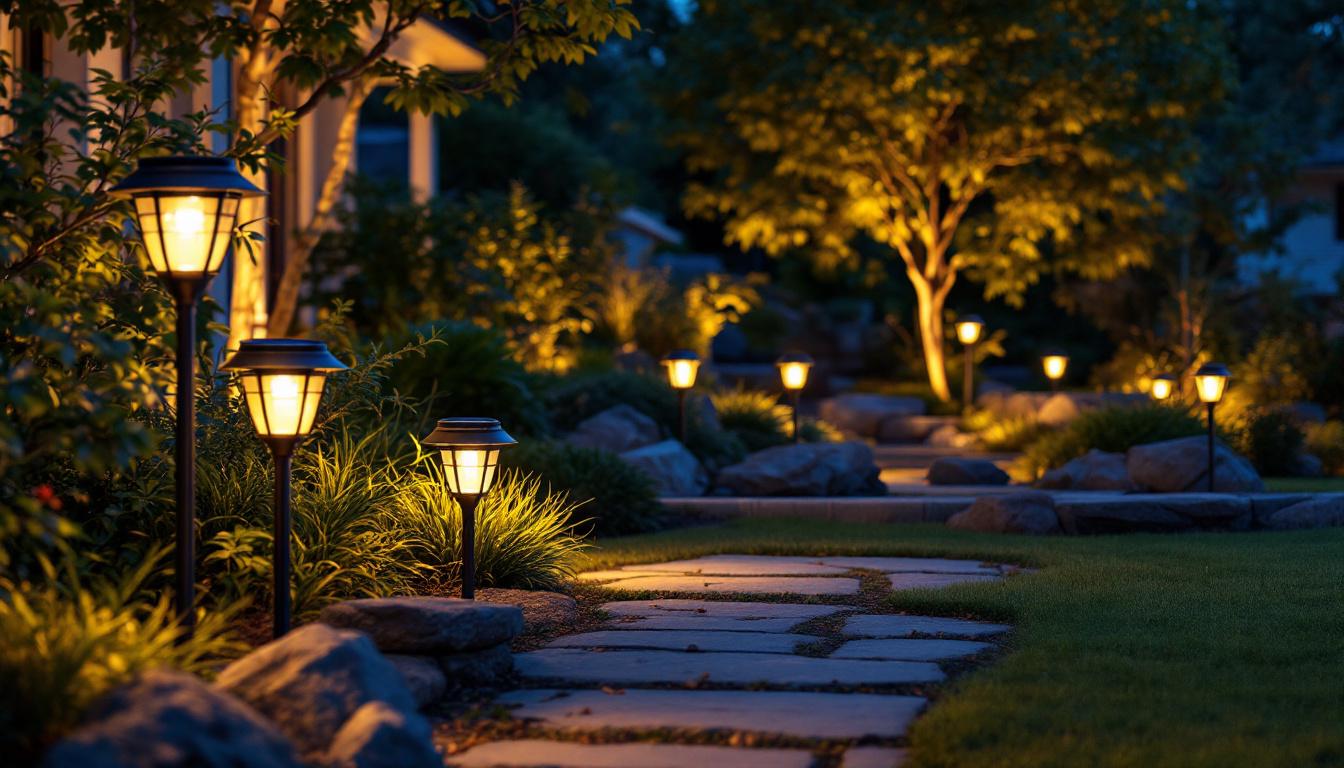
As the demand for sustainable and energy-efficient solutions continues to rise, outdoor solar lights have emerged as a popular choice for both residential and commercial properties. For lighting contractors, understanding the intricacies of solar lighting systems is essential to provide clients with the best options available. This guide delves into the various aspects of outdoor solar lights, offering insights into their benefits, installation considerations, and the latest trends in the market.
Solar lights operate by harnessing sunlight through photovoltaic cells, which convert solar energy into electrical energy. This technology not only reduces reliance on traditional power sources but also offers a range of benefits that appeal to environmentally conscious consumers. As the demand for renewable energy sources continues to grow, solar lighting stands out as a viable solution for both residential and commercial applications, contributing to a greener future.
Each solar lighting system consists of several key components, including solar panels, batteries, LED lights, and controllers. The solar panels capture sunlight and convert it into electricity, which is then stored in batteries for use during the night. LED lights are favored for their energy efficiency and long lifespan, while controllers manage the charging and discharging processes to ensure optimal performance. Additionally, many modern solar lighting systems are equipped with sensors that detect ambient light levels, allowing them to automatically turn on at dusk and off at dawn, further enhancing their convenience and efficiency.
One of the primary advantages of solar lighting is its sustainability. By utilizing renewable energy, solar lights significantly reduce carbon footprints and energy costs. Additionally, they are often easier to install than traditional lighting systems, as they do not require extensive wiring or access to electrical grids. This can lead to lower labor costs and quicker project turnaround times. Beyond cost savings, solar lighting also enhances safety and security in outdoor spaces. Well-lit pathways, gardens, and driveways deter potential intruders and provide a sense of safety for residents and visitors alike. Moreover, the versatility of solar lighting allows it to be used in a variety of settings, from urban environments to rural areas, making it an adaptable choice for diverse lighting needs.
While solar lights offer numerous benefits, proper installation is crucial to maximize their effectiveness. Lighting contractors must consider several factors to ensure that the systems function optimally.
Conducting a thorough site assessment is the first step in any solar lighting installation. This involves evaluating the amount of sunlight the area receives throughout the day, identifying potential obstructions such as trees or buildings, and determining the best locations for solar panels and fixtures. A well-planned site assessment can significantly enhance the performance of the solar lighting system. Additionally, it’s important to consider seasonal changes in sunlight exposure, as the angle of the sun shifts throughout the year. This knowledge can help in positioning the solar panels to maximize their efficiency across different seasons, ensuring consistent performance even during winter months when daylight hours are shorter.
Not all solar lights are created equal. Contractors should select products that are specifically designed for outdoor use and are equipped with high-quality components. Look for solar lights with durable housings that can withstand harsh weather conditions, as well as efficient solar panels and batteries that provide reliable performance. Additionally, consider the brightness levels and color temperatures of the LED lights to meet the aesthetic and functional needs of the project. It may also be beneficial to explore options with smart technology features, such as motion sensors or remote control capabilities, which can enhance energy efficiency and provide added convenience for users.
Proper installation techniques are essential for ensuring the longevity and efficiency of solar lighting systems. Contractors should follow manufacturer guidelines closely, ensuring that solar panels are positioned at optimal angles to capture sunlight. It’s also important to securely mount fixtures and ensure that wiring, if applicable, is protected from the elements. Regular maintenance checks can help identify any issues early on, ensuring that the system continues to operate effectively. Furthermore, understanding the local climate and soil conditions can influence installation methods; for example, in areas prone to high winds, additional anchoring solutions may be necessary to prevent fixtures from being dislodged. By taking these factors into account, contractors can provide a more robust and reliable solar lighting solution that meets the needs of their clients.
Solar lighting can enhance outdoor spaces in various ways, from illuminating pathways to accentuating landscaping features. Understanding how to design with solar lights can help contractors create aesthetically pleasing and functional outdoor environments.
Lighting design is not just about visibility; it’s also about creating ambiance. Solar lights can be used to highlight architectural features, create cozy seating areas, or guide visitors along pathways. By strategically placing solar fixtures, contractors can enhance the overall atmosphere of outdoor spaces, making them more inviting and enjoyable. For instance, warm-toned solar lanterns can evoke a sense of tranquility in a garden, while brighter, cooler lights can energize a patio for evening gatherings. The interplay of light and shadow created by these fixtures can also add a dramatic flair, transforming ordinary spaces into enchanting retreats.
When integrating solar lights into landscape design, it’s essential to consider the natural elements of the environment. Solar lights can be used to accentuate trees, shrubs, and garden beds, adding depth and dimension to the landscape. By choosing fixtures that complement the existing design, contractors can create a cohesive and harmonious outdoor space. Additionally, the use of solar lighting can promote sustainability by reducing reliance on traditional energy sources. This not only lowers energy bills but also aligns with eco-friendly practices that are increasingly important to homeowners. Incorporating solar lights with motion sensors can further enhance security while minimizing energy waste, making them a practical choice for both aesthetics and functionality.
Despite their many advantages, solar lighting systems do come with challenges. Being aware of these potential issues and having solutions ready can help contractors navigate common pitfalls.
One of the primary challenges with solar lights is their dependence on weather conditions. Extended periods of cloudy or rainy weather can reduce the efficiency of solar panels, leading to diminished performance. To mitigate this, contractors can recommend solar lights with larger battery capacities that can store more energy during sunny days, ensuring they remain operational even in less favorable conditions. Furthermore, integrating smart technology that adjusts brightness based on battery levels can also enhance performance, allowing the system to conserve energy during prolonged periods of low sunlight.
While solar lights generally require less maintenance than traditional lighting systems, they are not entirely maintenance-free. Regular cleaning of solar panels is necessary to ensure optimal performance, as dirt and debris can block sunlight. Additionally, contractors should advise clients on the importance of checking battery health and replacing components as needed to maintain functionality. It’s also beneficial to educate clients about seasonal maintenance routines, such as inspecting the fixtures for any signs of wear or damage after harsh weather conditions, which can prolong the lifespan of the solar lighting system. By establishing a clear maintenance schedule, clients can enjoy uninterrupted lighting and maximize their investment in solar technology.
The solar lighting industry is continually evolving, with new technologies and trends emerging to enhance performance and design. Staying informed about these developments can give contractors a competitive edge in the market.
Smart solar lighting systems are becoming increasingly popular, allowing users to control lighting remotely via smartphone apps. These systems can be programmed to adjust brightness levels based on time of day or occupancy, providing greater flexibility and energy savings. Additionally, many smart solar lights are equipped with motion sensors that can trigger illumination when movement is detected, further optimizing energy use and enhancing security in residential and commercial spaces. Contractors should consider integrating smart technology into their offerings to meet the growing demand for connected solutions, as this not only appeals to tech-savvy consumers but also aligns with the broader trend of home automation.
Design innovations in solar lighting are also on the rise, with manufacturers creating fixtures that blend seamlessly into various outdoor environments. From sleek, modern designs to more traditional styles, there is a wide range of options available to suit different aesthetic preferences. Furthermore, many new solar lighting products are being designed with sustainability in mind, utilizing recycled materials and energy-efficient LED bulbs that not only reduce the carbon footprint but also enhance the longevity of the fixtures. Contractors should stay updated on the latest designs to offer clients a diverse selection of products, as well as educate them on the benefits of choosing environmentally friendly options that contribute to a greener planet.
Outdoor solar lights represent a significant opportunity for lighting contractors looking to expand their services and provide clients with sustainable solutions. By understanding the technology, installation considerations, design possibilities, and market trends, contractors can effectively navigate the solar lighting landscape.
As the industry continues to evolve, staying informed and adapting to new innovations will be crucial for success. Embracing solar lighting not only benefits the environment but also positions contractors as leaders in the growing field of sustainable lighting solutions.
Ready to elevate your lighting projects with the most sustainable and cost-effective solutions? Look no further than LumenWholesale for a comprehensive range of outdoor solar lights that meet the highest industry standards. Our spec-grade lighting products come at unbeatable wholesale prices, providing you with the quality and affordability you need to outshine the competition. Say goodbye to middleman markups and hello to hassle-free bulk buying with free shipping. Make your next project a beacon of efficiency and style. Discover Wholesale Lighting at the Best Value today and join the ranks of satisfied contractors who choose LumenWholesale for all their lighting needs.

Discover the essentials of grid lighting compliance with our comprehensive guide tailored for lighting contractors.

Discover the science behind motion detect lights and how they enhance security, save energy, and improve lighting efficiency.

Discover effective strategies for training your team in the latest grow LED lighting technologies.

Discover how lighting contractors can enhance their business by mastering overhead lighting techniques.